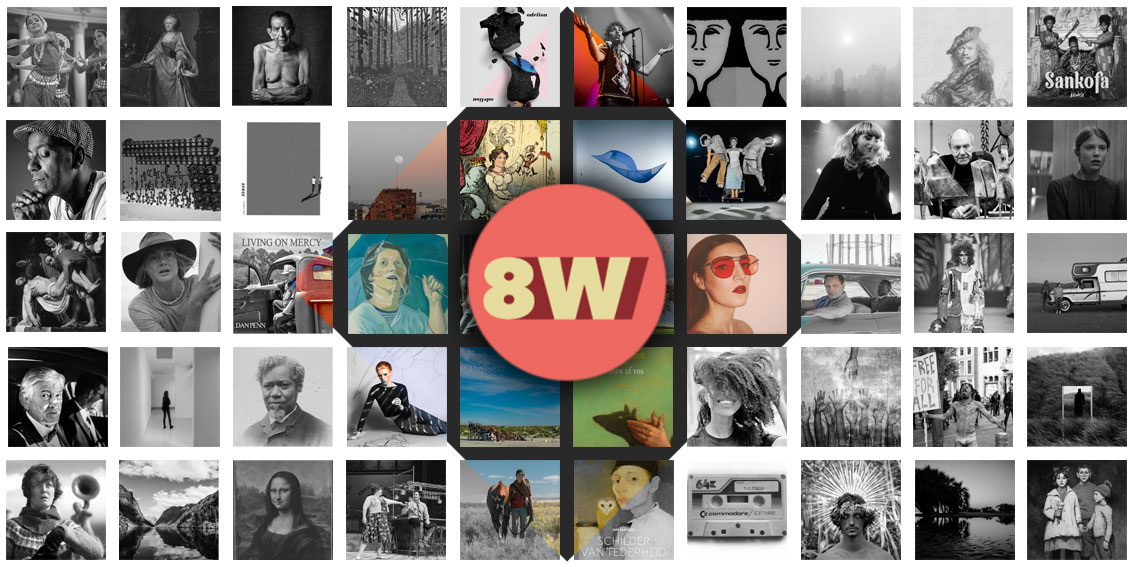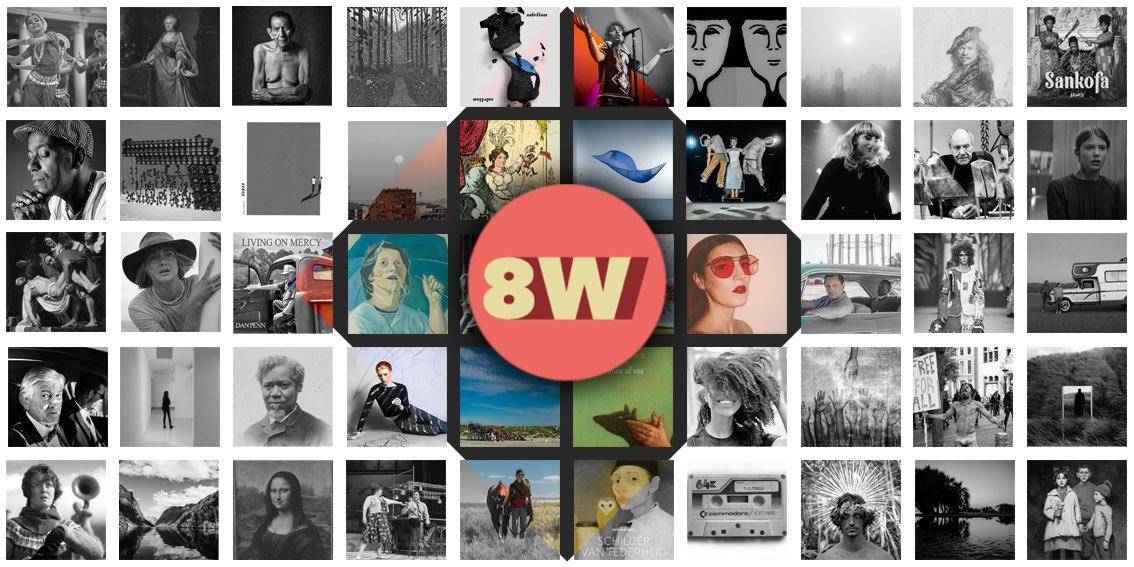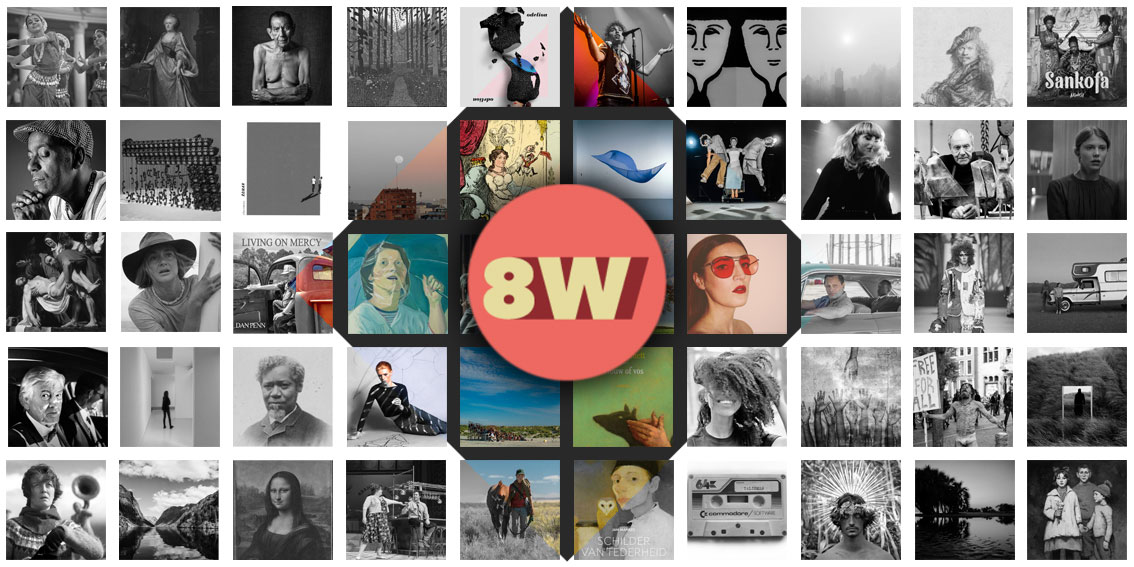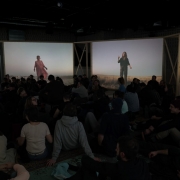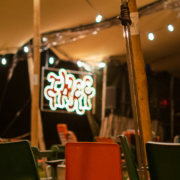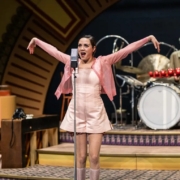
Festival in beweging
Iraqi GhostsMokhallad RasemSeen on 9 december at De Brakke Grond, Amsterdam
Iraqi GhostsBy Constantina Peter
Iraqi Ghosts holds its audience in a continuous game between surrealism and reality. The performance shows how humor and sarcasm are the only weapons available to people from the Middle East for commenting on their political and social life.
~
The magic carpetThe performers address the audience directly, pointing out the various ways someone can be killed in Iraq. They then continue with five different scenarios of the consequences of the war before and after. Using symbolic objects, the performers transport the audience into a cruel reality. Five carpets represent the different scenarios of lives that have experienced war. The violent world is presented with a sense of sarcasm, aiming not to engage the audience emotionally but present them a real version of this unfamiliar world, full of conflicts.
This Brechtian use of “estrangement” keeps the audience at a distance, turning the viewers into critical spectators, rather than passive onlookers. The director uses masks, music and video projections, gives fragments of all kind of truths about war, which makes the use of this theatre technique very effective. The actors use a variety of languages: the Flemish Sarah Elsa and Julia Clever deliver their lines in German, Flemish, and English, while the Iraqi actors, Ahmed Khaled and Duraid Abbas, perform mostly in Arabic. The resulting chaotic atmosphere refers to the result of the war and the loss of a national identity. However, the audience was also lost at times, because it was impossible to follow this plethora of languages, voices and simultaneous representations.
Stage as PlaygroundThe director of Iraqi Ghosts uses several techniques and theatrical elements to keep the audience focused. Furthermore, the mastery of the performers in the way they transform into surrealistic figures or narrators of their personal experiences of war, engage the gaze of the viewer.
Iraqi Ghosts is a journey where the real and the subconscious combine in a game, creating a stage as a playground. In this playground the performers attempt to share their emotions and thoughts on war. It’s a shame that, at times, they left the audience lost in translation.
Iraqi Ghosts was te zien op Dancing on the Edge op 9 december 2011.Terug naar boven
AleefToufiq IzzediouSeen on 8 december at Frascati, AmsterdamThe Universality of Dance LanguageBy Oana Tarce
Aleef is an energetic performance that combines African traditions with contemporary dance. Hilarious, emotional, childish, serious, and sometimes bewildering, this piece is a touching affirmation of the universality of dance and its power to speak directly to us.
Het kan niemand zijn ontgaan: het Midden-Oosten is in beweging. En zijn kunstenaars bewegen mee. Het festival Dancing on the Edge toont voorstellingen van voor de opstanden en van erna; in alle voorstellingen is de turbulentie voelbaar. Dat maakt Dancing on the Edge dit jaar extra indringend. DEEL 1 | DEEL 2 | DEEL 3
Masterstudenten Theatre studies aan de Universiteit Utrecht bezochten het festival en doen daarvan verslag bij 8WEEKLY. Lees nu de recensies van: Iraqi Ghosts | Aleef | Othello (twee recensies). Drie van deze recensies zijn geschreven door buitenlandse gaststudenten, en zijn daarom in het Engels geschreven.The performers address the audience directly, pointing out the various ways someone can be killed in Iraq. They then continue with five different scenarios of the consequences of the war before and after. Using symbolic objects, the performers transport the audience into a cruel reality. Five carpets represent the different scenarios of lives that have experienced war. The violent world is presented with a sense of sarcasm, aiming not to engage the audience emotionally but present them a real version of this unfamiliar world, full of conflicts.
This Brechtian use of “estrangement” keeps the audience at a distance, turning the viewers into critical spectators, rather than passive onlookers. The director uses masks, music and video projections, gives fragments of all kind of truths about war, which makes the use of this theatre technique very effective. The actors use a variety of languages: the Flemish Sarah Elsa and Julia Clever deliver their lines in German, Flemish, and English, while the Iraqi actors, Ahmed Khaled and Duraid Abbas, perform mostly in Arabic. The resulting chaotic atmosphere refers to the result of the war and the loss of a national identity. However, the audience was also lost at times, because it was impossible to follow this plethora of languages, voices and simultaneous representations.
Stage as Playground
The director of Iraqi Ghosts uses several techniques and theatrical elements to keep the audience focused. Furthermore, the mastery of the performers in the way they transform into surrealistic figures or narrators of their personal experiences of war, engage the gaze of the viewer.
Iraqi Ghosts is a journey where the real and the subconscious combine in a game, creating a stage as a playground. In this playground the performers attempt to share their emotions and thoughts on war. It’s a shame that, at times, they left the audience lost in translation.
Iraqi Ghosts was te zien op Dancing on the Edge op 9 december 2011.
Terug naar boven
Aleef
Toufiq Izzediou
Seen on 8 december at Frascati, Amsterdam
The Universality of Dance Language
By Oana Tarce
Aleef is an energetic performance that combines African traditions with contemporary dance. Hilarious, emotional, childish, serious, and sometimes bewildering, this piece is a touching affirmation of the universality of dance and its power to speak directly to us.
~
East and West
The search for an identity is the visual premise of the entire piece: the dancer moves around a massive light system on stage, which creates a dance of shadows played by a moving silhouette that flows organically from one type of melody to the other. Western music, ranging from trance to noise, and from Nina Simone to Tiger Lilies, is contrasted by traditional African music. Adil Amimi, a renowned Gnawa musician, plays an African traditional song live on stage. His brief appearance reveals a confusing ambivalence. On one hand, our hero is deeply rooted in traditions which is reflected in his ritual dance performed side by side with the musician. On the other hand, one cannot help but notice the resemblance between this traditional song and the psychedelic music of the Sixties. Even the spectators start to move along the Morocco rhythms, one by one.
A powerful presence
Izzediou’s slightly corpulent physique is charmingly complemented by his deft, often surprisingly gracious, movements. He shows a great deal of mastery of a wide range of dance styles. No matter how abstract some parts of his choreography are, his dancing is highly expressive in revealing his quest for a self identity. The performer is able to make the auditorium resonate with his own state of being, which goes from a revolted to a fearful one, from an amusing to a serious one, from a playful to a grotesque one, from a joyous to an exhilarating one.
All in all, Aleef shows us how every conflict is followed by a state of peace, and how every duality is ultimately overcome by its own unity. The fluctuation between East and West, ritual and contemporary is reflected in the energetic and vivid dance movements. In the end, the scene is brightly lit. The clash is resolved by its consummation through what is an enjoyable piece of contemporary dance.
Aleef was te zien op Dancing on the Edge van 8 t/m 17 december 2011.
Terug naar boven
Othello
Groep: Indra Theatre Group
Choreograaf: Atefeh Tehrani
Gezien op 11 december in Theater Kikker, Utrecht
Fysiek ‘Othello’ uit Iran
Een voorstelling waar restricties artistieke vondsten worden
Door Eline Habraken
De Indra Theatre Group brengt Nederland een uiterst fysieke en intense enscenering van Shakespeare’s Othello, waarbij de beperkingen vanuit Iran worden gebruikt als artistieke uitdagingen.
~
Aanrakingen en erotische spanning
Interessant aan deze performance zijn de artistieke uitwegen die Tehrani heeft moeten inbouwen in haar choreografie, vanwege het feit dat het in Iran verboden is dat mannen en vrouwen elkaar aanraken. De zakdoek, die uiteraard een zeer belangrijke rol speelt in Othello, heeft om die reden een nog veel belangrijkere functie gekregen in deze Iranese enscenering. Via de zakdoek is het namelijk wel toegestaan om als man in ‘contact’ te komen met een vrouw, en andersom. Er vinden op deze manier geen echte aanrakingen plaats, maar wanneer twee spelers elk een ander uiteinde van de zakdoek vasthebben, zijn ze toch verbonden. Waar de zakdoek dus in het verhaal zorgt voor een grote kloof tussen de hoofdpersonages Othello en Desdemona, zorgt hij in het Iranese fysieke theater juist voor een brug tussen man en vrouw. Een toch wel belangrijk gegeven in een enscenering van Othello, waar erotische spanning tussen man en vrouw een grote rol speelt.
Professionele achtergrond
Ondanks dat er in Iran vrijwel geen dansopleidingen te vinden zijn, kan de danskwaliteit van de performers alles behalve onprofessioneel worden genoemd. Tehrani heeft via verschillende wegen inspiratie gekregen voor haar choreografieën, waaronder internetfilmpjes van de choreografieën van de uiterst bekende choreografen Pina Bausch en William Forsythe. De intensiteit die beide choreografen incorporeren in hun dansstijl, is duidelijk terug te herkennen in deze performance. In Iran mag het dan absoluut niet gemakkelijk zijn om vrijuit artistiek te kunnen creëren, Tehrani met haar Indra Theatre Group laat zien dat het wel mogelijk is.
Othello
Gezien op 10 december in Frascati, Amsterdam
The Power of Body Language
By Cristina Rotariu
It doesn’t matter if you know or not the play Othello by W. Shakespeare, because everybody will understand the impressive story, due to the clear and mastery translation of words into body language, creating a high quality physical performance.
Atefeh Tehrani, director and choreographer of Othello, used to work under Hamed Mohammad Taheri, who introduced contemporary physical theater to Iranian artists. Having recently established her own theatre group, she wanted to stage an adaptation of Shakespeare. Othello has many opposite situations and antagonistic feelings that can be beautifully captured in movement: love and hate, good and evil, loyalty and betrayal, truth and lies. Tehrani’s choice for this play has nothing to do with their political situation, but with the challenge of the characters and story, which they respected entirely. Dancing on the Edge Festival is interested in artists’ views on Middle Eastern society. The Iranian group works in a modern manner when it comes to performing, but adhere to and respect traditional values.
The stage design is a simple white construction of nine columns, one for every performer. They are exploited to their full advantage, giving the impression of a palace. The costumes are white, black and gray, representing the fight between good and evil. The simple but expressive lighting design emphasizes the emotions of every scene.
The impressive cast shape their characters with mastery. All of the dancers have a background in theatre and acting, but none of them studied modern dance, because of the lack of universities and the delicate situation of contemporary dance in Iran. This has not prevented them from becoming professional dancers and they demonstrate that passion and determination are more important than a high education for becoming a professional.
In a talk after the performance, the group told that after reading the text together, each of them searched for an animal that resembled their character. Iago is not played by an African man, but by a small and thin Iranian, dressed completely in black. He is extremely convincing and very talented. His movements and attitude are those of a snake. The girls were also very good, expressive and sensual, despite of their demure costumes. And even if the man is not allowed to touch a woman on stage, they managed to respect that and in the same time to create communication and relations between them using scarves and other materials.
This touching and emotional physical theatre composed with organic movements and powerful emotions, made the performance an intense experience for the audience. It is a high quality performance which brings the story of Othello translated in body language on stage, without losing any of the Shakespearian essence.
Othello was te zien op Dancing on the Edge van 10 t/m 15 december 2011.
Terug naar boven


